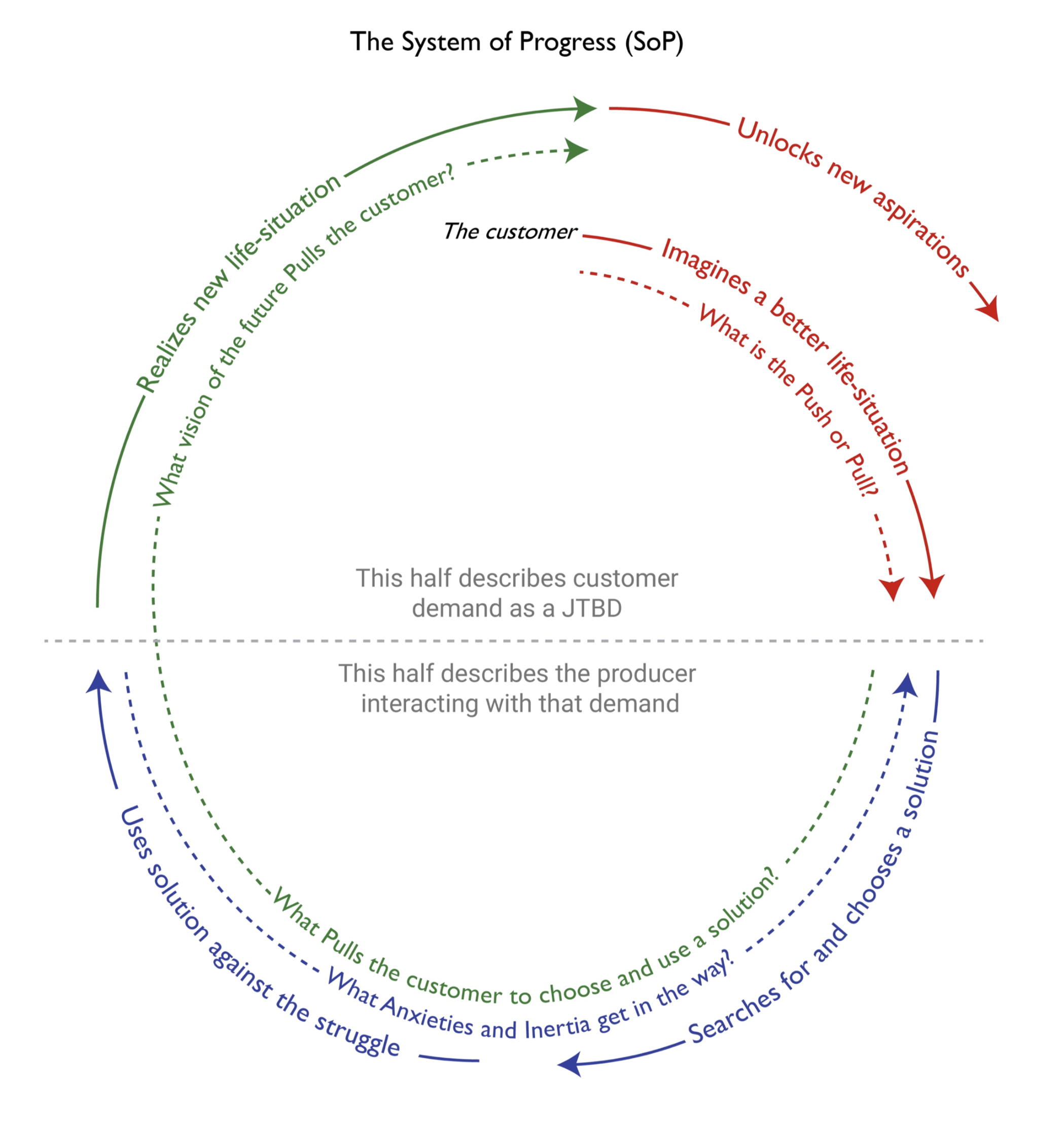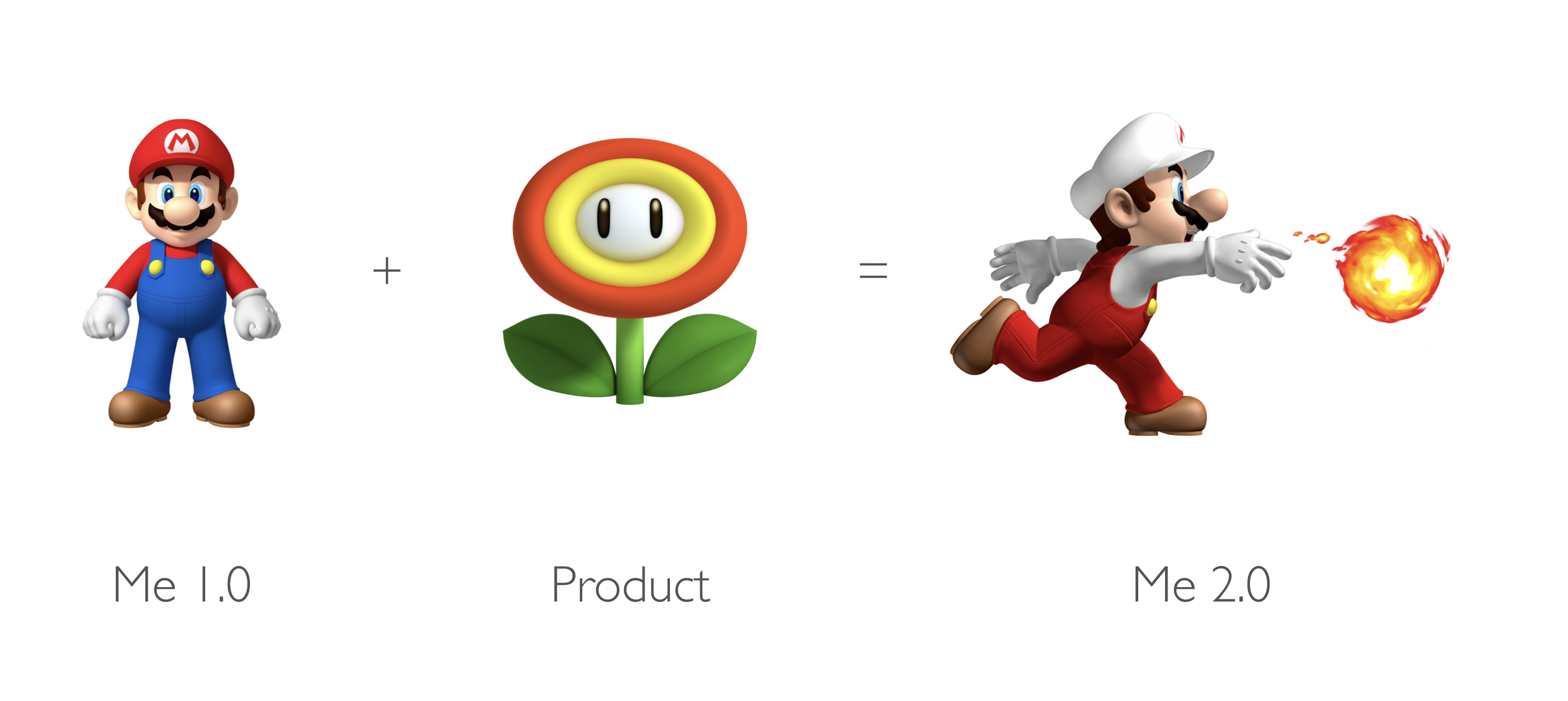Evolution, Revolution, and Progress
November 05, 2019
This post is part of my notes on three years of design leadership at Pipedrive. Also read the other posts in the series:
- Notes from a few years of leading design at Pipedrive
- Imagine, Say, and Do
- Axes
- Design Leads meeting
- Evolution, revolution, and progress
- The research mix
- The album
During my time at Pipedrive, we did some work with Alan Klement and Eric White with their flavour of Jobs-to-be-Done. I enjoyed studying their material like the coffee and kale book, and the in-person workshops and customer interviews that we had. I’m not able to point to specific outcomes it had on the Pipedrive business, but I can discuss two key ideas that stuck with me. Which are really two facets of the same idea.
Customer superpowers
The first one is giving superpowers to your customer. Here’s a popular picture from Samuel Hulick’s UserOnboard post.

We referred to this idea extensively through our JTBD work. We spoke about how the customer does not really care about our product - they care about their own business, as they should. In case of Pipedrive, we operate in the world of sales, so the customer is interested in having sales superpowers so they are successful in sales. They have many different ways to accomplish that: hard work, training, talent, hiring specialists, Pipedrive, our competitors, any other tools. In order to give them superpowers with our product, we first need to understand their thinking, motivation, end goals, and all those sorts of things that really have nothing to do with either our product or technology.
Progress
The second concept that I got really attached to is progress. Here are some images from the coffee and kale book, describing the same thinking as above, but from a different perspective.


The coffee and kale book goes into detail about this System of Progress, the different forces that accelerate or hinder the circle, disruptions that may happen half-way, and so on.
I started to like this thinking because it is such an optimistic, forward-looking way to pull myself out of the weeds whenever I get stuck. As designers and product people in the technology industry, we have these incredible tools and business models at our disposal which we can use to facilitate progress at all kinds of levels. And what should always come first is the human we are doing this for, and what kind of progress they desire in their own life and business.
My own take on the progress story
I thought about the above pictures and the customer’s growth journey quite a lot. I first redrew the “fireballs Mario” for myself with higher-fidelity assets and using the terms that Alan and Eric use in their work, referring to the customer imagining a “new me”.

This illustrates just one iteration of progress-making. Over a period of time, the customer might go through several iterations of this, take shortcuts, or have pre-existing skills so that they enter the system at a different location. Here’s what I think is a more complete image, indicating a more nuanced reality over longer time.

Customers can enter the system from many directions, and go through a lifecycle of progress, using different superpowers at different times. There might be shortcuts, or parallel journeys. You could model the customers in various stages as different personas, and have various product offerings appropriate for different stages and configurations of their journey.
As a designer and researcher, all this is very exciting to research and work on, in the context of your actual business and customers. There are many wonderful methods available to put the above approaches into practice and bring your whole team along, and I find it one of the more fulfilling parts of my work.
The two worlds of evolution and revolution
If you happen to work in the industry, you might look at the above material and ask yourself, all this about understanding your customers and designing intentional ways for them to make progress sounds incredible, but is this what I really do? Do I show up to work every day and get to deal with Mario, flowers and fireballs?
For me, the answer is definitely no. I don’t do much of that most of the time. I deal with much more mundane things like looking into some browser bug, researching a usability issue of a particular customer, making an existing workflow slightly more efficient, thinking of how to incrementally improve some particular metric, and so on. But is that where the magic, progress and innovation really happens?
I realized that there are two modes of design and product work, that I’d call evolution and revolution.
Evolution is where I solve well-understood problems with incremental improvements, and clear ways to evaluate and measure the outcome against a known baseline.
Revolution means making radical progress, taking risks and solving wicked problems with an opinionated attitude because there is no good baseline or measurement available. You are less concerned with previous baggage and what’s holding you back (“reasons why it can’t be done”), and more concerned with, how do we take a meaningful bold step forward for our business and customers. There are many ways to model what this actually means and how to do it. What I had above about the superpowers and progress was just one of the ways, and a long-winded intro to get to this point.
Let’s contrast these two worlds across a few dimensions.

Evolution is incremental change and revolution is radical change. In nature, single-cell organisms didn’t turn into primates and eventually humans overnight. It was a long series of gradual mutations and adaptation. The same in product development where evolution means taking something that already exists as a solution or a well-understood problem, and making a small or large improvement to it. Revolution, on the other hand, means breaking into unknown territory and trying something radically new or different.
Evolution is backwards-looking: you reference something that already exists. There may be risks, but they are understood and contained. Revolution looks forward, which, again, means jumping into the void with many unknowns and a lot of risk.
Evolution is measurable. There is often a clear goal and a metric to improve. Revolution deals with wicked problems, and one property of those is that while there is some ultimate goal you have in mind (in case of business, commonly revenue), there is no single obvious path to get there, and no clear single local metric to use to understand if you’re making progress at all, or by how much, until it starts to impact the bottom line.
Evolution deals with giving customers what they want. Fixing bugs reported by customers is a very obvious example. Is it groundbreaking? No, it can often be tedious and boring. Should you still do it? Absolutely, because bugs, or lack of them, and your responsiveness to bug reports and how you handle the related customer communication, can be a differentiator between a great and lousy customer experience.
Revolution, on the other hand, gives customers things they don’t know they want. It is about implementing your own vision of how the world should be, which hopefully aligns with enough other people that it gets traction, even though probably not a single person explicitly asked for exactly such a thing. You had enough vision and abstraction power to take a large body of customer requests, state of the market, competition, technology, and any other inputs, and brew it all into something new and meaningful.
The labels of science and opinion are perhaps not the best, but I couldn’t think of more clear ones to illustrate the difference. By “science” in evolutionary work, I just mean that the process is more clearly defined, manageable, gradual, and measurable. There is a clear null hypothesis. “Opinion” in revolution means exactly that: you have an opinion of what the world should be, take a deep breath, and then take a leap of faith.
What’s the use?
Okay. Let’s say there really are these two modes of evolution and revolution. So? Why talk about them? What’s the point?
A key point from practical product management and design perspective is that these two modes need different tools and methods to actually get the work done. Evolution is more on the practical and production side, where the task is clear and you just go ahead and get the job done. Revolution is much more about figuring out and deciding what’s the problem to begin with, and only then, how can you tackle it.
Errors can happen if you approach the situation with the incorrect mindset. There’s a stereotype about a designer who insists on endlessly zooming out, researching, reframing, and remodeling every single little evolution task, even though sometimes it would be much more economical to do the minimum amount of work and just pick the first satisficing solution, so that more creative energy is left for tasks that actually need it.
Conversely, sticking only with evolutionary thinking is a great path to “death by mediocrity” where seemingly you do the right things in the right order, but never really achieve any breakthroughs. Eventually, someone smarter, bolder and faster will just take over.